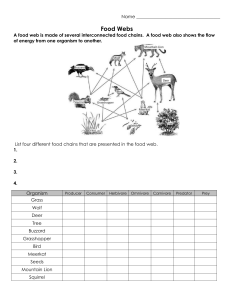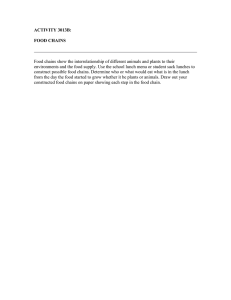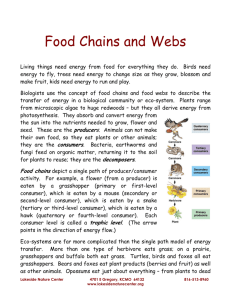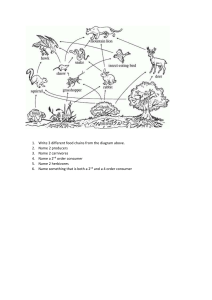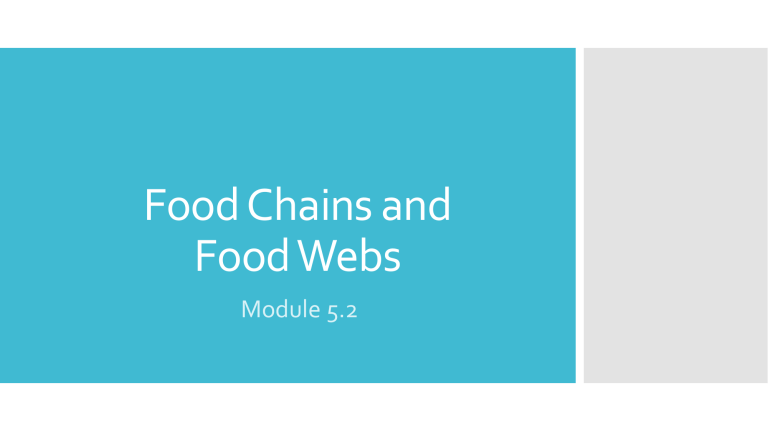
Food Chains and Food Webs Module 5.2 Can you see a food chain in this habitat A food chain is a sequence that shows how each individual feeds on the organism below it in the chain. leaf Food Chains caterpillar bird fox What does this food chain show? A leaf is eaten by a caterpillar, which is then eaten by a bird, which is then eaten by a fox. The arrow always points to the mouth. Energy is transferred from one organism to another in the direction of the arrow. All food chains always start with a producer If the producer is a plant, only a small part of it might be involved in the food chain, such as its seeds, fruits, leaves or even dead leaves. Producers But how do plants produce their food or energy? leaf snail bird owl Photosynthesis • Photosynthesis is the process in which plants can make their own food (hence they are called autotrophs) • Plants use energy from the sun to combine the carbon dioxide and water to form glucose (sugar) and oxygen Carbon dioxide LIGHT Water Glucose Oxygen Photosynthesis Identify any mistakes in the following food chains: Chain 1 This chain is missing a producer Snail bird Food Chains Chain 2 This chain is correct Lettuce caterpillar magpie Chain 3 The arrow is the wrong way Human apple An Antarctic food chain Draw the following food chains into your workbook Feeding types Different types of organism can be grouped in several ways. One grouping system is based on how organisms obtain their food. Some organisms produce their own food. We already know that they are called producers. Plants produce their own food using light energy from the Sun. Some types of bacteria can also make their own food by using light or chemical reactions. Other organisms cannot make their own food. They are called consumers They have to eat in order to get their energy. Also known as heterotrophs Producer or Consumer Producer Draw the following table in your book Consumer Decomposer Producer or Consumer Consumers can be grouped into different types: Herbivore Carnivore Omnivore Eats both plants and animals Eats other animals Eats plants Consumers Decomposers Feeding Types Consumers eat plants or animals, or both. A food chain can be used to rank different types of consumers. Ranking Consumers seaweed limpet crab human producer primary consumer secondary consumer tertiary consumer Producers – make their own food. Primary consumers – eat producers. Secondary consumers – eat primary consumers. Tertiary consumers – eat secondary consumers. Primary, Secondary or Tertiary Here's another food chain, with a few more animals. It starts with acorns, which are eaten by mice. The mice are eaten by snakes, and then finally the snakes are eaten by hawks. At each link in the chain, energy is being transferred from one animal to another. Food chains There can be even more links to any food chain. Here another animal is added. Grass to grasshopper to mouse to snake to hawk. • There is actually even more to this chain. • After a hawk dies, fungi (like mushrooms) and other decomposers break down the dead hawk, and turn the remains of the hawk into nutrients, which are released into the soil. • The nutrients (plus sun and water) then cause the grass to grow. It's a full circle of life and energy!! Food chains So food chains make a full circle, and energy is passed from plant to animal to animal to decomposer and back to plant! There can be many links in food chains but not TOO many. If there are too many links, then the animal at the end would not get enough energy. Food chains Can you think of a consumer that eats only one kind of food? What do consumers eat? Do most consumers eat only one kind of food? If consumers can eat more than one kind of food, how can we show this with a diagram? Food webs sparrow owl stoat bluebird moth spider vole ladybird aphid plant 1. Name the producer in this food web. 2. Name two herbivores in this food web. Using a food web 3. Name two species that are top carnivores. 4. How many secondary consumers are there? 5. Which food chains include the moth? Build a food web Food Web Cut and Paste Activity Construct food web on A3 paper Ensure arrows are pointing in the right direction Label each organism as producer/first order/ second order/ third order consumer Label all consumers as a herbivore/carnivore/omnivore Make 5 food chains from your food web Some animals are very sensitive to change Animals can become extinct due to changes This will effect the entire food web Changes in food webs Animals can be directly or indirectly effected Eg: Change in temperature (coral) Eg: Hunting (rabbits) Eg: Disease Food webs chiffchaff owl stoat bluebird moth spider vole ladybird aphid plant Food webs What would happen to this food web if the moth was removed??? chiffchaff owl bluebird moth spider ladybird aphid plant • Everything will be affected! • There will be more plants only the aphid will eat the plants • The Spider will not have a food source and die (direct impact) • The Chiffchaff will not have a food source (spider) and die (indirect impact) • The Bluebird will have less food therefore more competition for ladybirds (ladybird population will decrease) • The Owl will have less food also On your A3 food web answer the following questions Activity 1. Propose what would happen to the vole population if the grasshoppers disappeared from the area 2. Propose what would happen to the frog and snake populations 3. Explain any other animals which will be affected if the grasshopper population disappears


